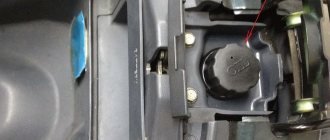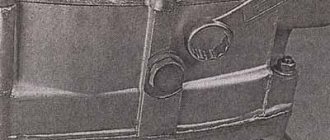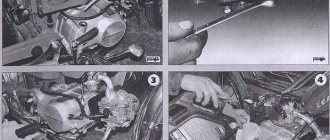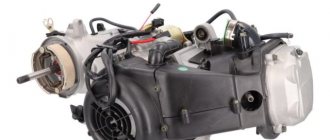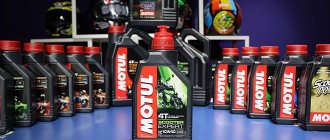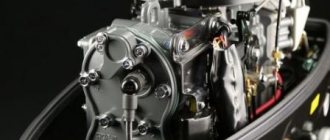| № | Name | Rating | Nomination |
| 1 | Bel-Ray Scooter Synthetic Ester Blend | 4.89 | The best ratio of price and quality |
| 2 | LIQUI MOLY Motorbike 4T | 4.86 | Maximum compatibility |
| 3 | Eni/Agip i-Ride Scooter | 4.77 | Most popular oil |
| 4 | LUKOIL Moto 4T 10W-40 | 4.72 | Best price |
| 5 | ELF Scooter 4 City | 4.69 | Pure synthetic |
| 6 | Castrol Power 1 Scooter | 4.65 | The most reliable engine protection |
| 7 | Motul Scooter Expert | 4.36 | The best oil for displacement engines |
| 8 | Mannol 4-Takt Plus | 4.16 | Universal purpose |
| 9 | Gazpromneft Moto | 3.84 | |
| 10 | AMSOIL Formula 4-Stroke Synthetic Scooter Oil | 3.74 |
The answer to the question of which oil is best to pour into a 4-stroke scooter engine sounds short and banal - the one recommended by the manufacturer. But if you have a 150cc Honda or a new European, this recommendation can hurt your pocket. However, budget Chinese brands are not shy about recommending top-end lubricants, and if your finances allow it, then it’s better to do just that. In all other cases, you will have to look for an analogue. Fortunately, there are a lot of them on the market, and in a variety of price categories.
First of all, you need to find out which SAE classification the manufacturer recommends filling. We will build on it. In most cases, oils in the range from 5W-20 to 10W-40 are used. In rare cases, the numbers may be higher, but, as a rule, they are used in engines with high mileage. The recommended grade may vary and change. For example, depending on the climatic characteristics of your region. The first digit in the value shows what the minimum temperature should be to crank the engine. If you live in the north or use the scooter in cold weather, go for 5w or lower. For southern regions and summer rides the value may be higher.
The viscosity class - the second digit in the designation - is determined individually based on the characteristic features of the engine. Numbers above 40 are practically never used in scooters. Well, one more criterion is the brand. It is important to find a balance between the quality of the lubricant and its price. It is very difficult to do this without personal experience or professional recommendations. In our article, we take into account the opinions of experts and reviews of ordinary users, so we choose only the best options and not with an exorbitant price tag.
Top 10. AMSOIL Formula 4-Stroke Synthetic Scooter Oil
Rating (2021): 3.74
12 reviews from resources taken into account: Yandex.Market, Ozone
- Characteristics
Price per liter: 670 rub.
- Country: USA
- Type: synthetic
- Viscosity: 10W-40
Quite a rare guest on the shelves of Russian stores. American motor oil designed specifically for scooters and motorcycles with small engines. Fully synthetic lubricant with a unique set of additives that allows it to be poured even into diesel engines. Of course, this quality is irrelevant for two-wheeled vehicles, but it makes it possible to use the lubricant in generators and special equipment that runs on diesel fuel. According to the classification, it is suitable for both new engines and those that have traveled more than one thousand kilometers. Provides reliable protection of parts and also compensates for the gap between them.
Advantages and disadvantages
- Suitable for all scooters
- Has no mileage restrictions
- Difficult to find in stores
Transmission lubricants
In modern scooters it is already difficult to find a gearbox in its traditional sense - with manual mechanical shifting. Regulation of the speed transmitted by the engine to the wheels is carried out by CVTs of various designs. The CVT scheme involves the integration of two or three-stage reduction gearboxes into the transmission of scooters.
Again, taking into account the predominantly summer operation of motorcycles, it is better to pour oil of more viscous modifications into the scooter. The most widely used transmission liquid lubricants are 80W90 or 75W90, although it is safer to check the recommended viscosity values in the scooter’s passport documentation.
It is better not to use additional additives - high-quality transmission oils are produced with a full range of additives necessary to ensure effective lubrication of gears, which have been tested for compatibility with the base oil.
Top 9. Gazpromneft Moto
Rating (2021): 3.84
50 reviews from resources taken into account: Yandex.Market, Otzovik
- Characteristics
Price per liter: 540 rub.
- Country Russia
- Type: synthetic
- Viscosity: 10W-40
New on the Russian market from the giant Gazpromneft. This manufacturer could not stand aside and also decided to produce oil for scooters with four-stroke engines. More precisely, simply for 4-stroke engines, without describing what equipment they are installed on. The API classification is very broad, which allows us to talk about the versatility of the product. The structure of the lubricant is completely synthetic, which affects the price, which is not the lowest for a Russian brand. Separately, it is necessary to say about the unique set of additives. It is not new, and is used in almost all lubricants of the manufacturer. It has high oxidation resistance and anti-corrosion properties. This allows you to pour lubricant into engines with any degree of wear, and also use it to clean the crankcase of accumulated dirt.
Advantages and disadvantages
- Oxidation stability
- Anti-corrosion properties
- Universal purpose
- Synthetic base
- No specific purpose for scooters
- New on the market
Engine oil requirements for a two-stroke engine
The technological solution for providing lubrication in an internal combustion engine of a two-stroke cycle is carried out in two ways.
- Mixing gasoline and lubricant when filling the fuel tank.
- Separate supply of fuel and lubricant components. The issue is resolved in two-stroke diesel engines in a similar way. There are two tanks: the main one is filled with fuel; in the auxiliary - oil.
Industry use of two-stroke diesel engines is quite limited. Most often these are marine engines with a long piston stroke. For users, the first method is more common. It is used
- on mobile equipment: motorcycles, scooters, motorbikes, walk-behind tractors, motor-cultivators and other devices;
- for small-scale mechanization in everyday life: chainsaws, brush cutters, drilling rigs and a number of other devices.
Main characteristics of motor oil
- Viscosity is the ability to form a stable film on the contact surface of mechanical elements. For heat engines, it is necessary to ensure the stability of this indicator over a wide temperature range (-20...+60 ⁰С).
- Turnover is the second important indicator. The lubricating fluid must fill the space provided to it. When starting the engine, its temperature is still quite low, so it is necessary for oil to penetrate the crank mechanism and settle on the cylinder walls.
- Presence of anti-stick additives. This requirement arose relatively recently. Components began to be added approximately 20...25 years ago. As a result, breakdowns are less likely to occur due to rings being stuck in the piston grooves. At temperatures above 2000...2100⁰С, which is observed during fuel combustion, additives do not allow the oil to form crystals that settle at different points where it is difficult to wash them out.
- Antifoam additives prevent the formation of gas bubbles on the surface of the oil film. Where a gas bubble is present, the film thickness is minimal. “Dry” contact between mating parts is possible.
- Anti-corrosion properties. The lubricant should not be oxidized by oxygen contained in the air. Therefore, the composition necessarily contains a small amount of saturated hydrocarbons (paraffins). They form a protective coating on the surface that prevents oxygen from reaching the metal.
- Solubility in gasoline is an indicator without which a lubricant cannot be used. In practice, it is necessary to create fuel-lubricant mixtures with different ratios. For heavy motorcycles, it is necessary to prepare a heavy proportion, in which 15...25 parts of fuel are poured into 1 part of oil. For light trimmer motors, a light mixture is needed; a proportion of 1: 40...50 is maintained.
- The stability of properties is characterized by the preservation of initial indicators over a long period. The liquid should not separate. Precipitation of inclusions is not allowed.
At the heart of a motor lubricant there is a load-bearing part, as well as additive components that determine the main characteristics of the material.
Top 8. Mannol 4-Takt Plus
Rating (2021): 4.16
22 reviews taken into account from resources: Yandex.Market, Otzovik
Universal purpose Oil with a wide range of approvals. Suitable for both small scooters and powerful motorcycles, as well as special equipment using four-stroke engines.
- Characteristics
Price per liter: 430 rub.
- Country: Germany
- Type: semi-synthetic
- Viscosity: 10W-40
It doesn’t matter what kind of scooter you have, whether its engine has 50 cc or more than 150 – this oil can be poured anywhere. Even into a chainsaw or generator. The main thing is that the engine is four-stroke. Many experts argue that such versatility is unacceptable, but judging by the reviews, the oil is of quite high quality. In addition, the brand has long established itself in the market and is famous as a manufacturer of high-quality lubricants at attractive prices. Unfortunately, we do not know what technologies the company uses in production. You can only rely on user comments, and they are mostly positive and even laudatory. Oil can also be used as a topping, which is also a plus.
Advantages and disadvantages
- Wide range of applications
- A brand with an impeccable reputation
- Little information about components and additives
- Virtually no protection against copying and counterfeiting
Lukoil
For two-stroke engines, there is also a domestic, budget option: mineral oils with additives Lukoil MOTO 2T (MGD-14M). For everyday driving in the city and country roads, this oil is quite suitable, but you should remember that it should be changed more often than synthetics and semi-synthetics (for 4t engines). A big plus of this product: minimal risk of running into a fake.
What to choose is up to you, the main thing is to follow the recommendations of both the machine manufacturer and oil manufacturers.
Top 7. Motul Scooter Expert
Rating (2021): 4.36
23 reviews taken into account from resources: Yandex.Market, Ozone, Otzovik
The best oil for displacement engines It is recommended to fill the lubricant into four-stroke engines with a displacement of 150 cubic meters and above. Provides maximum protection of parts under high loads.
- Characteristics
Price per liter: 700 rub.
- Country: France
- Type: semi-synthetic
- Viscosity: 10W-40
If your scooter's engine has a displacement of more than 150 cc, then it requires special oil. Many people try to simply fill in motorcycle lubricants, but, as experts say, this is not the best way out. One solution to the problem is Motul Scooter Expert, an oil designed specifically for large scooters. It makes no sense to pour it into 50 cc engines, although it will not harm them. The product is specially designed for high loads, which is important for large engines. It can also be used in cases of high wear of parts, when it is necessary to compensate for gaps formed over time. Add here an expanded classification, including Japanese types, and we get an excellent product, although quite expensive.
Advantages and disadvantages
- Recommended for engines from 150 cc
- Suitable for all four-stroke engines
- Increased consumption noted
- Not the most attractive price
Features of two-stroke engines and the lubrication system on engines of this type
First of all, the operating cycle of any internal combustion engine consists of:
- intake, when the cylinder is filled with a fuel-air mixture;
- compression (the working mixture is pre-compressed in the cylinder);
- ignition of the fuel charge and transfer of energy to the piston;
- release of exhaust gases from the cylinder;
If in a 4-stroke engine such a working cycle is completed in 2 revolutions of the crankshaft, then in a 2-stroke engine it is completed in one. In other words, the working cycle of a 2-stroke engine is conventionally a “combined” mixture intake, compression and power stroke, which do not occur in separate strokes (as in 4-stroke internal combustion engines).
During compression, the piston rises from BDC to TDC (top and bottom dead center). At the same time, special “windows” are structurally implemented in the engine instead of more conventional valves. As the piston moves upward, the so-called purge window is first closed (the mixture enters the cylinder through it), then the exhaust window is closed (exhaust gases exit the cylinder through it).
Accordingly, when the windows are blocked, the working mixture is compressed. At the same time, a vacuum is formed in the crank chamber, due to which the next portion of the mixture is “drawn” from the carburetor. Next, the piston approaches TDC, a spark from the spark plug ignites the compressed mixture, gases appear, which expand and push the piston down. This energy from the piston is transferred to the crankshaft and it rotates.
While the piston is making its power stroke, pressure increases in the crank chamber, which leads to compression of the working mixture that was there during the previous stroke. After the surface of the piston reaches the exhaust window area, it opens, which allows exhaust gases to be discharged into the exhaust system.
Then the piston similarly opens the purge window, through which the mixture, which is already under pressure in the crank chamber, enters the cylinder and displaces the remaining exhaust gases. Next, the mixture fills the space above the piston. After the piston reaches BDC, the entire cycle of operation of a two-stroke engine is repeated again.
If we talk about the lubrication system, two-stroke engines may not have a separate solution for this purpose at all. Simply put, these engines are lubricated by mixing gasoline and oil in the right proportion (for example, 1/25 or 1/50). Moreover, such a mixture is not only a mixture of air and gasoline, but also includes oil particles.
It is enough to recall the principle of operation of a two-stroke engine, after which it becomes clear that the circulation of such a mixture in the crank and piston chambers makes it possible to lubricate the loaded elements of the internal combustion engine (connecting rod bearings, crankshaft bearings, cylinder walls, etc.) At the moment when the fuel mixture burns out, the lubricant burns out at the same time, after which the cylinder is purged.
As for the methods of mixing oil with fuel, there are two of them:
- Motor oil is poured directly into the tank along with the fuel. This is the simplest solution.
- fuel and lubricant are in separate tanks, and the gasoline-oil mixture is formed in the inlet pipe, which is located between the cylinder itself and the carburetor.
The second scheme is more complex and requires the presence of not only an oil tank and a line for supplying it, but also a plunger-type pump. Thanks to this design, oil is supplied in doses, taking into account the amount of mixture of gasoline and air.
Without going into details, the pump produces greater output depending on how far the “gas” handle is twisted. The more the gas is turned, the more fuel is supplied, which means an increase in the supply of lubricant. A separate lubrication system on a two-stroke engine makes it possible to more accurately balance the ratio of oil to the amount of gasoline, the engine smokes and cokes less, oil consumption is reduced, etc.
So, a comparison of the lubrication systems of a two-stroke engine and a 4-stroke engine clearly demonstrates that these engines are very different. In four-stroke internal combustion engines, oil is supplied to the loaded parts under pressure and circulates through special channels. In this case, the lubricant practically does not enter the combustion chamber, that is, only the fuel-air mixture burns in the cylinders.
In 2-stroke internal combustion engines, it is assumed that not only fuel and air are burned, but also the lubricant itself. Taking into account the above, it becomes clear that the requirements for oils for 2-stroke engines are very different.
Oil for two-stroke air-cooled engines and other similar internal combustion engines must leave a minimum amount of carbon deposits in the cylinders after combustion, mix well with the fuel, retain its properties as long as possible and better, etc.
Top 6. Castrol Power 1 Scooter
Rating (2021): 4.65
46 reviews from resources taken into account: Yandex.Market, Otzovik
The most reliable engine protection The brand uses a special magnetization technology, thanks to which the lubricant envelops the parts as much as possible and extends their service life, protecting them from abrasion.
- Characteristics
Price per liter: 510 rub.
- Country: Britain
- Type: synthetic
- Viscosity: 5W-40
Filling with Castrol oil means extending the life of the engine. This lubricant uses a special technology that makes the particles magnetized. This is true for both automobile and motorcycle oils. The oil is completely synthetic, which is also an advantage. The thickening temperature is 5 degrees, that is, it is excellent for use in cold weather. The product can also be used in engines with high wear. The same unique enveloping technology perfectly compensates for increased gaps and copes even with heavy loads. It doesn’t matter whether you have 50 cc or 150, Castrol oil will suit any scooter, and the Honda concern even recommends it as an alternative to the original oil.
Advantages and disadvantages
- Low pour point
- Unique magnetization technology
- Can be used in engines with high wear
- Very often copied
- Not suitable for all scooter models
Honda Dio 34 (Honda Dio 34) – repair
If you are even slightly interested in motorcycles, then you probably know that the most common scooter in Ukraine is the Honda Dio. The scooter models of this Japanese manufacturer have gained such popularity due to their reliability and durability. Indeed, the equipment of this manufacturer shows excellent technical characteristics on the roads, but, despite all the positive aspects, sooner or later you will still need repairs to the Honda Dio 34 scooter.
Honda Dio AF 34 (Honda Dio AF 34) – repair
Repairing the Honda Dio AF 34 scooter can be entrusted to professionals or you can do it yourself. Having chosen the latter option, you need to find a reliable and trusted store where you can buy original spare parts and components for your scooter at a price that is acceptable to you. You can, of course, contact a specialized service center, but in this case, even the most minor repair of the Honda Dio 34 (Honda Dio 34) can cost you quite a tidy sum.
So, if you intend to repair the Honda Dio 34 moped on your own, then our online store is what you need! Here you will find any spare parts for Honda Dio 34 and can purchase them at the most reasonable prices in Ukraine. But before starting to disassemble the complex components of the scooter, experts recommend cleaning and adjusting the carburetor, as well as checking the condition of the filters, since the cause of many scooter problems is incorrectly selected or completely low-quality oil or unqualified carburetor adjustment.
Honda Dio 34 fuel pump repair (Honda Dio 34)
Surely all scooter owners know that the fuel supply to the engine is provided by a special pump, on which, by the way, the dynamic performance of the scooter depends. If the fuel pump fails, the engine simply will not start or this process will be somewhat labor-intensive. That is why, at the first suspicion of a malfunction in the fuel pump, you should contact mechanics who will eliminate the problems that have arisen at the initial stage of their occurrence, which in turn will allow you to avoid more serious problems and, accordingly, high costs.
If you want to purchase an original fuel pump for the Honda Dio 34 scooter at the most reasonable prices, then you can do this in our online store.
Honda Dio 34 engine repair
All engines, regardless of their purpose, have operating life limits, after which they require repairs, which involve replacing worn-out parts. You can get ahead of the fact that your engine needs repairs based on several signs, namely:
- Extraneous noise and loud engine operation.
- Metallic knock in the engine.
- Black or bluish smoke from the exhaust pipe.
- Increased fuel consumption.
- Increased oil or antifreeze consumption.
- Significant difference in pressure in the cylinders.
- Large or, conversely, small compression in the cylinders.
If you notice at least one of the above problems on your scooter, then most likely you need engine repair.
Honda Dio 34 front fork repair
If you observe jamming, distortions in the operation of the front fork, or they do not work in the same planes, then with a 99% probability you need to have it repaired.
If you want to repair the fork of your scooter with your own hands, you need to familiarize yourself with its design, because the outer and inner tube are very often connected by a locking ring, which can only be accessed by pulling off the rubber seal. Also, the outer tube can be tightened with the inner pipe with a vertical or horizontal bolt.
It must also be remembered that the design of the telescopic fork implies the presence of rigid springs located inside the stays, so experts recommend disassembling this part with extreme caution to avoid injury. After replacing a particular part, the fork should be cleaned of dust and other contaminants using rags and gasoline. In the case of an oil fork, before disassembling it, drain the oil and refill it in the amount specified by the manufacturer. You can purchase a new fork or spare parts for it through our online store.
Honda Dio 34 muffler repair
The most common problem with scooters, especially Japanese models, is a clogged muffler. Carbon deposits that form both on the walls of the muffler and in the engine CPG are a consequence of the combustion of fuel and oil. You can determine that your muffler is clogged by the following signs:
- The scooter doesn't start well.
- The scooter accelerates slowly.
- Problems with traction.
All these troubles should tell you that you urgently need to check the exhaust pipe and muffler, which may be clogged, which leads to narrowing of the channels and, as a result, suppression of power. If you are unable to clean the channels, you will need to replace the entire muffler.
Honda Dio 34 crankshaft repair
Problems with the crankshaft can seriously affect the operation of the engine or even lead to failure of other main components of any motor vehicle. Therefore, it will be very important for drivers to identify problems in a timely manner and eliminate them as soon as possible.
Crankshaft wear can be identified by the following signs:
- Loss of power.
- Oil leaking from the crankcase.
- Strong engine vibration while driving.
If you find one or more of the above problems, then you will need to remove the engine cylinder and piston to replace the rings or crankshaft assembly.
Honda Dio 34 gearbox repair
Typically, gearbox repair involves replacing bearings and gears, since these parts are considered the most vulnerable and are subject to faster wear than shafts and other components. You can recognize that the gears require replacement by the characteristic hum of the gearbox.
Replacing bearings or gears yourself is quite simple; to do this, you just need to remove the variator cover and the rear clutch pulley, behind which the gearbox cover will be located. Remember, if you do not replace the bearings in a timely manner, this can lead to rapid wear of other important gearbox parts, which will entail additional costs.
Honda Dio 34 – CVT repair
A variator or centrifugal clutch, as a rule, can serve you for more than five years, because this is the wear period guaranteed by the manufacturer. But despite this, the scooter’s variator may fail after the first season. To prevent this from happening, experts recommend disassembling the variator and performing appropriate preventative work on it, which should be carried out immediately before each season.
If the variator needs repair, then you can feel this during the operation of the scooter, which, when riding, will lose maximum speed, smoothness and accelerate slowly. The reason for this behavior may be worn out variator rollers, which need to be replaced as soon as possible. You can buy a new variator or spare parts for it through our online store.
Honda Dio 34 (Honda Dio 34) – carburetor repair
Even the smallest particles of dust and dirt can cause wear on fragile carburetor parts. They settle on the parts of the carburetor, getting into it along with gasoline, as well as during frequent use of the scooter on rough terrain and dirt roads. Therefore, many scooter riders, taught by bitter experience, regularly inspect and clean the carburetor. Carburetor malfunction can also be caused by improper adjustment.
Top 5. ELF Scooter 4 City
Rating (2021): 4.69
13 reviews from resources were taken into account: Yandex.Market, Otzovik
Pure synthetics The oil is completely synthetic, which puts it above its closest competitors that use semi-synthetic production technology. High quality product especially for scooters.
- Characteristics
Price per liter: 550 rub.
- Country: France
- Type: synthetic
- Viscosity: 10W-40
Among oils for scooters with 4-stroke engines, synthetic products are quite rare. They are expensive to produce, and since the scooter itself is an unpretentious piece of equipment, semi-synthetics are quite suitable for it. But the French brand ELF doesn't think so. This is a synthetic lubricant of the highest quality. It is suitable for all types of scooters. Recommended by manufacturers such as Honda, Kawasaki and Suzuki, even though they have their own motor oils. At the same time, the price tag does not deter. 550 rubles per liter is, of course, not little, but not much either. Note that some top manufacturers charge much more, even for mineral water.
Advantages and disadvantages
- Maximum quality
- Affordable price for synthetics
- Recommended by top scooter manufacturers
- Cannot be mixed with other lubricants
- The choice of viscosity is very poor
Benefits of synthetic oil
In addition, during combustion, synthetic oil emits less so-called soot, which clogs the muffler and contributes to the formation of soot in the combustion chamber.
In this case, carbon deposits significantly reduce the life of the engine and interfere with its normal operation. Carbon deposits complicate the normal movement of the compression rings, creating a load and additional overheating. Constant overheating and solid deposits can lead to serious engine damage and costly repairs.
Top 4. LUKOIL Moto 4T 10W-40
Rating (2021): 4.72
48 reviews from resources taken into account: Yandex.Market, Ozone
Best price Cheapest motor oil specifically for scooters and motorcycles. One liter of lubricant costs about 15% less than its nearest competitor and is half the price of top brands.
- Characteristics
Price per liter: 270 rub.
- Country Russia
- Type: semi-synthetic
- Viscosity: 10W-40
Recently, the Russian brand Lukoil has launched the production of special oils for motorcycles, scooters and snowmobiles. The set of basic additives in it has changed, the consistency and viscosity have changed. In addition, it is recommended to pour it into tools equipped with 4-stroke engines. That is, the oil is universal. Whether this is good or bad is difficult to judge. One thing is certain, a top brand would never agree to such a combination of appointments. However, buyers speak well of the product and praise it for its characteristics and large resource. In addition, oil can be poured on top of another. You do not have to completely drain the previous product and clean the crankcase. An excellent option if topping up is needed.
Advantages and disadvantages
- Multi-purpose lubricant
- Can be used as a top-up
- Affordable price tag
- Lots of fakes
Features of two-stroke engines
The operating cycle of any engine consists of the following stages.
- Inlet. During this period, the cylinder is filled with a fuel-air mixture.
- Compression. The working mixture is pre-compressed in the cylinder.
- Ignition of the fuel charge, as well as transfer of energy to the piston.
- Exhaust gas release from the cylinder.
In a two-stroke engine, such a work cycle is completed in one revolution of the crankshaft, and in a four-stroke engine - in two. The working cycle of a two-stroke engine conventionally consists of a combined mixture intake, compression and power stroke, which do not occur in separate strokes (as in a four-stroke engine).
When compressed, the piston rises from bottom dead center to top dead center. In the engine, instead of the usual valves, special windows are structurally implemented. When the piston moves upward, the purge window through which the mixture enters the cylinder is first closed, and then the exhaust window is closed through which the exhaust gases leave the cylinder.
Compression of the working mixture occurs when both windows are closed. A vacuum is formed in parallel in the crank chamber. Thanks to this, the subsequent portion of the mixture is drawn in from the carburetor. After this, the piston approaches top dead center, the compressed mixture is ignited by a spark from the spark plug, and gases are formed that expand and push the piston down. Energy is transferred from the piston to the crankshaft and its rotation begins.
While the piston is making its power stroke, the pressure in the crank chamber increases. This leads to compression of the working mixture that was there during the previous stroke. After the piston surface reaches the exhaust window area, it opens and exhaust gases are discharged into the exhaust system.
After this, the piston opens the purge window in the same way and the mixture, which was in the crank chamber under pressure, enters the cylinder through it, displacing the remainder of the exhaust gases. After this, the space above the piston is filled with this mixture. After the piston reaches bottom dead center, the operating cycle of a two-stroke engine is repeated again.
Lubrication system
Two-stroke engines may not have a separate solution for lubrication systems. Such engines are lubricated by mixing oil and gasoline in the required proportion (1:25 or 1:50). Such a mixture is not only a combination of gasoline and air, it also includes oil particles.
You just need to remember how a two-stroke engine works, and it will become clear that the circulation of such a mixture in the piston and crank chambers will allow lubrication of the loaded parts of the internal combustion engine (cylinder walls, crankshaft bearings, connecting rod bearings and others). During the period when the fuel mixture burns, the lubricant burns out simultaneously with it. After this, the cylinder is purged.
Fuel and lubricant are mixed in two ways.
- Lubricant and fuel are located in separate tanks, and an oil-gasoline mixture is formed in the inlet pipe. This pipe is located between the carburetor and the cylinder.
- Motor oil is poured directly into the tank along with the fuel. This is the simplest solution.
The first scheme is more complex. It assumes not only the presence of a tank for oil and a line through which it will be supplied, but also a plunger-type pump. It is thanks to this design that the oil will be supplied in doses and take into account the amount of mixture of air and gasoline.
Without going into details, it can be noted that the pump will produce greater performance depending on how much the gas handle is twisted. The more the gas is turned up, the more fuel is supplied. This means that the supply of lubricant will be increased. On a two-stroke engine, a separate lubrication system allows you to more accurately balance the ratio of gasoline and oil. This results in less coking and smoke from the engine, and reduced oil consumption.
In a four-stroke engine, oil is supplied under pressure to the loaded parts, and it circulates through special channels. Almost no lubricant enters the combustion chamber. Only the fuel-air mixture burns in the cylinders.
In two-stroke internal combustion engines, not only air and fuel are burned, but also the lubricant itself. From this it is clear that the requirements for oils will be different. After combustion, the oil should leave a minimal amount of soot in the cylinders, retain its properties for a long time, and mix well with the fuel.
Top 3. Eni/Agip i-Ride Scooter
Rating (2021): 4.77
71 reviews taken into account from resources: Yandex.Market, Ozone, Otzovik
The most popular oil Lubricant from a famous brand, which has surpassed all competitors in terms of the number of reviews. The product is often found in test reviews and is recommended by professional mechanics.
- Characteristics
Price per liter: 470 rub.
- Country: Italy
- Type: semi-synthetic
- Viscosity: 10W-40
If you've ever had your scooter repaired by a mechanic, you've probably heard of this brand. It is this that is most often recommended to be poured into 4-stroke engines, and it does not matter whether you have 150 cubic meters or just 50. In addition, the name can be found in the technical documentation of many scooters and motorcycles. At least those brands that do not produce their own lubricants. The lubricant is especially recommended for owners of sports equipment subjected to heavy loads. Accordingly, an ordinary city scooter will feel just great with it. As experts from the Drive portal say, loading Agip i-Ride means loving your bike and wishing it many years to come.
Advantages and disadvantages
- Recommended for heavy loads
- Often mentioned by professional mechanics
- Strictly controlled quality
- Weak protection against counterfeiting
- Do not pour on top of another lubricant
See also:
- 20 best motor oils
What don't two-stroke engines like?
When preparing the working mixture manually, it should be remembered that two-stroke engines do not reach their designed operating power if the proportions of the fuel mixture are violated. The above condition forces the owner of the unit to comply with the proportions. As practice shows, when using a brush cutter with an underfill of lubricant, the engine is starved of oil, which does not allow the unit to reach standard power.
Excess lubricant prevents the engine from developing the required power. When preparing the working mixture, a reasonable question arises as to how much oil needs to be mixed in gasoline. Helps to accurately determine the standard. It is recommended to fill gasoline into the trimmer according to the following mathematical calculation. If the fuel tank holds 5 liters, 1 liter of gasoline is divided by 50. That is, 100 ml of lubricating consistency is poured into gasoline for the trimmer for 5 liters. The owner of a brush cutter receives an ideal fuel based on its structural composition.
Top 2. LIQUI MOLY Motorbike 4T
Rating (2021): 4.86
21 reviews taken into account from resources: Yandex.Market, Ozone, Otzovik
Maximum compatibility The oil has an extended classification according to API and ACEA, which allows it to be used in 4-stroke engines with any mileage and with varying degrees of wear.
- Characteristics
Price per liter: 800 rub.
- Country: Germany
- Type: mineral
- Viscosity: 10W-40
The LIQUI MOLY brand has long established itself in the market and is in constant demand among both car and motorcycle enthusiasts. The product is designed specifically for scooters with a 4-stroke engine. It has excellent viscosity indicators and an extensive list of purposes in different classifiers. It doesn’t matter if you have a new 150 cc Honda or a budget Chinese bike with a 50 cc engine, this oil can be poured into any system. Even having traveled more than one thousand kilometers. 40 viscosity units will fill even large spaces between worn parts, and a set of additives will remove all the dirt that has accumulated over years of operation from the crankcase. The price is not very good, but you have to pay for the quality.
Advantages and disadvantages
- Compatible with most motors
- Only high-quality additives and components
- High ratings from buyers and experts
- Availability on the market
- High price
- The brand is often counterfeited
See also:
- 10 Best Motorcycle Oils
What kind of oil to pour into a two-stroke scooter
What kind of oil to put in a two-stroke scooter? Let's try to answer this question directly. Below are the highest quality oils that can be safely recommended for any 2T vehicles, regardless of the year of manufacture and engine condition. These are proven brands with a good reputation:
- Motul (all generations),
- Mol Dynamic,
- Castrol Power
- Castrol Act Evo
- Castrol R2 Racingbike,
- Liqui Moly Racing Synth 2t,
- Ipone Self 2t,
- Ipone Samourai Racing,
- Repsol Moto Sintetico 2t,
- Repsol Moto Off Road 2t,
- Repsol Moto Racing 2t,
- Repsol Moto Competicion 2T.
Recommendations for proper use of scooters
Denis replied: May 15 in Norm. I myself have been riding a Yamaha for 7 years. Didn't find the answer to your question? Ask your question directly in the comment box. To receive qualified help, describe your situation in detail, following the spelling rules.
Leave a comment Click here to cancel reply. Cancel commenting. Still have questions? Register on the forum. Everything about repair, maintenance, tuning of scooters, mopeds and light motorcycles. Welcome to our club.
We discuss on the forum:.

